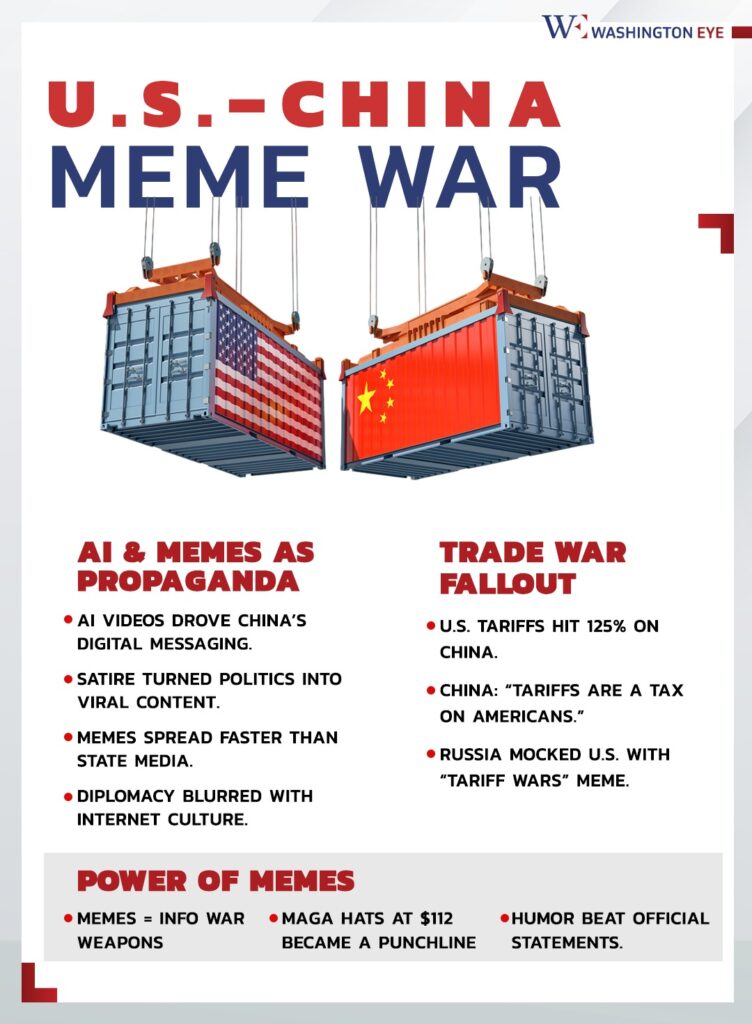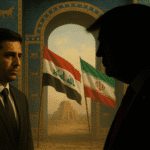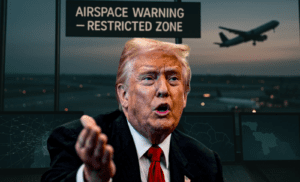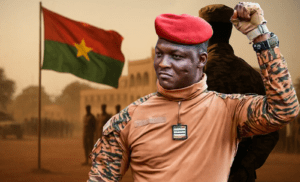The first time I saw it, I had to do a double take. A fluorescent-lit factory floor, rows of bloated, sluggish Americans hunched over sewing machines, drenched in sweat, fumbling with fabric like they’d never touched a needle before. A twangy, traditional Chinese tune played in the background. It wasn’t real — that much was obvious. It was an AI-generated video, surreal and strangely hypnotic, that had erupted on Chinese social media. But it struck a nerve.
The message was blunt: this is what Trump’s so-called manufacturing revival looks like — a parody of itself, reduced to overweight Americans collapsing into their overalls while the slogan “Make America Great Again” blinked ironically across the screen.
It wasn’t just satire. It was a calculated swipe, a digital jab dressed in slapstick. And before long, it had spilled from WeChat and Douyin into my own feed — X, Reddit, Telegram — racking up millions of views. But it wasn’t just a one-off gag. It was the first shot in a full-blown meme war between the U.S. and China, with AI-crafted videos becoming the latest frontline in a very 21st-century kind of propaganda battle.
What followed was a barrage. I saw Trump and Elon Musk, of all people, in matching jumpsuits and safety glasses, slumped at a sneaker assembly line, gluing soles with industrial glue while a sign overhead read “American Factory.” J.D. Vance was there too, MAGA hat blurred out, sweating over an iPhone assembly. The absurdity was the point — these titans of capitalism reimagined as blue-collar workers, victims of their own protectionist dreams. The joke was brutal and brilliant: if tariffs mean bringing jobs home, then maybe even billionaires should get a taste.
China’s meme-makers weren’t pulling punches. These weren’t just grassroots efforts either — state accounts got involved. I watched as the Chinese Embassy in the U.S., usually buttoned-up and formal, dropped memes into the chaos. One was a cartoon of Uncle Sam offering candy with one hand, while hiding a spiked bat in the other — a twisted metaphor for U.S. diplomacy that even Musk noticed and laughed at. Another showed MAGA hats priced at over a hundred bucks — “thanks, tariffs.” Satire was now state-sanctioned.
But it wasn’t one-sided. American users hit back. Some called the portrayals unfair — after all, real American workers in the Rust Belt still clock in and grind every day. One user angrily posted about their mom sewing for 20 years just to keep food on the table. Others fired back with irony of their own. I came across memes showing Trump shooting Uncle Sam in the foot, then blaming Biden. The infamous Eric Andre gun meme was repurposed for tariff politics. Even Ian Bremmer joined in, tweeting a picture of penguins “protesting” in the Heard Islands over Trump’s tariff list.
Somehow, amid this surreal circus, the Russians jumped in too. The Russian Embassy in Kenya, of all places, tweeted a meme titled “Tariff Wars” showing the U.S. in a chaotic brawl with everyone else, while Russia relaxed, watching from the sidelines. Elon Musk chimed in with a “😂” emoji. If that’s not peak 2025, I don’t know what is.
By then, it was more than entertainment — it was narrative warfare. The Chinese were pushing a clear message: Trump’s tariff crusade is self-inflicted sabotage. The U.S., by imposing massive duties on Chinese imports, was only hurting itself. These memes packaged that claim in digestible, viral nuggets — a form of soft-power theater designed not just for Chinese audiences, but for global consumption. And it worked. People laughed, but they also listened.
When the White House tried to reclaim the narrative by tweeting a “LET HIM COOK!” meme featuring Trump and Vance, it felt like a wink — a reluctant admission that even the administration had to play by meme rules now. It was strange seeing a government lean on Gen-Z slang for legitimacy, but that’s the landscape we’re in. Policy debates aren’t just fought in summits or press conferences — they’re fought in memes, threads, and reposts.
For me, the most remarkable part was watching how propaganda adapted — how it slipped into the rhythms of internet culture without missing a beat. What once would’ve been delivered in longwinded op-eds or government broadcasts was now encoded in AI videos and punchy cartoons. And it worked because it didn’t feel like propaganda. It felt like a joke, until you realized you were nodding along.
Memes are powerful because they’re sticky. That image of obese American workers, or Uncle Sam wielding a spiked club — those linger longer in the mind than a spreadsheet of tariff stats ever could. And in the context of the U.S.-China trade clash, they’ve become tactical weapons — less brute force, more narrative finesse.
By the end of that week, trade negotiations had stalled. But the meme war was in full swing. Chinese diplomats quoted Mao with hashtags. U.S. users replied with frog memes. Everyone had a take, and everyone had a laugh. But behind the humor was a chilling truth: public opinion is up for grabs, and memes are now tools of influence.
This wasn’t just a battle of tariffs — it was a battle for perception. And in the global town square we call the internet, that can be just as critical. Even as the real consequences of this trade war loom large — rising prices, disrupted supply chains, political fallout — the war of jokes rolls on.
And somewhere between the satire and the spite, the question lingers: In a world where memes carry more weight than manifestos, who’s really winning?
















